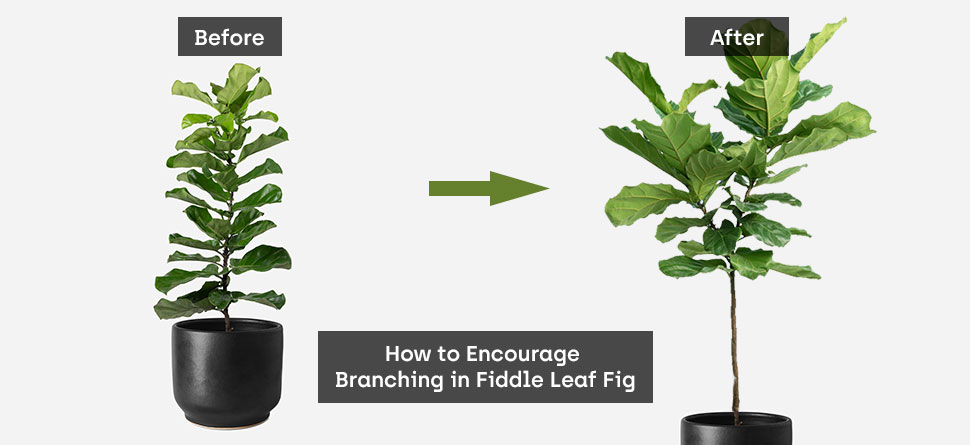Introduction
Fiddle leaf figs are native to tropical rainforests and thrive in warm, humid environments. When grown indoors, they require specific care to ensure optimal growth and branching. By understanding the factors that influence branching and implementing proper techniques, you can transform your fiddle leaf fig into a lush and vibrant plant.
Why Branching is Important for Fiddle Leaf Figs
Branching is crucial for fiddle leaf figs as it helps create a fuller and more compact plant structure. When a fiddle leaf fig branches, it develops multiple stems from its main trunk, resulting in a bushier appearance. Branching also promotes better light distribution throughout the plant, allowing lower leaves to receive sufficient sunlight for photosynthesis.
Factors Affecting Branching in Fiddle Leaf Figs
Several factors contribute to the branching habits of fiddle leaf figs. By understanding and optimizing these factors, you can encourage healthier and more abundant branching.
Adequate Lighting
Proper lighting is essential for fiddle leaf figs to thrive and branch effectively. These plants prefer bright, indirect light but should be shielded from intense, direct sunlight. Placing your fiddle leaf fig near a north or east-facing window can provide the ideal lighting conditions.
Proper Watering
Watering plays a crucial role in the overall health and growth of fiddle leaf figs. Overwatering can lead to root rot and hinder branching, while underwatering can cause stress and leaf drop. Aim to keep the soil slightly moist, allowing the top inch to dry out before watering again.
Appropriate Fertilization
Fiddle leaf figs benefit from regular fertilization to ensure they receive essential nutrients. Choose a balanced, water-soluble fertilizer specifically formulated for houseplants. Apply the fertilizer according to the package instructions during the growing season, typically from spring to early fall.

Techniques to Encourage Branching in Fiddle Leaf Figs
Now that we have a better understanding of the factors that influence branching, let’s explore some effective techniques to encourage branching in your fiddle leaf fig.
Pruning and Pinching
Pruning and pinching are essential techniques for shaping and stimulating branching in fiddle leaf figs. Remove any damaged, diseased, or leggy branches with clean pruning shears. Pinching involves gently squeezing and removing the new growth tips to encourage side shoots and bushier growth.
Read More Notching a Fiddle Leaf Fig
Rotating the Plant
Rotating your fiddle leaf fig periodically helps ensure even exposure to light. By rotating the plant every few weeks, all sides of the plant receive adequate light, preventing the growth of one-sided or leaning branches.
Adjusting Lighting Conditions
If you notice your fiddle leaf fig leaning towards a specific light source, it may indicate an imbalance in lighting conditions. To encourage branching on all sides, adjust the plant’s position or use sheer curtains to diffuse light evenly.
Providing Adequate Nutrients
In addition to regular fertilization, incorporating organic matter or compost into the potting soil can supply essential nutrients to the fiddle leaf fig. This nourishment promotes overall plant health and encourages branching.
Using Support Stakes
Support stakes can be used to train your fiddle leaf fig’s branches to grow in the desired direction. Gently tie the branches to the stakes using soft plant ties, allowing the plant to form a fuller and more compact shape.
Maintaining Healthy Branches
To ensure the longevity and attractiveness of your fiddle leaf fig’s branches, it’s crucial to maintain their health through regular inspection and care.
Regular Inspection
Inspect your fiddle leaf fig regularly for signs of pests, diseases, or any issues with the branches. Look for yellowing or browning leaves, spots, or unusual growth patterns. Early detection and appropriate treatment can prevent further damage and encourage branching.
Treating Diseases and Pests
If you notice any signs of diseases or pests, take immediate action to address the issue. Common problems for fiddle leaf figs include fungal infections, scale insects, spider mites, and mealybugs. Follow appropriate treatment methods, such as using neem oil or natural insecticides, to protect your plant and encourage healthy branching.
Common Mistakes to Avoid
While encouraging branching in fiddle leaf figs, it’s essential to avoid common mistakes that can hinder growth and vitality.
One common mistake is over-pruning. While pruning is beneficial, excessive or improper pruning can stress the plant and impede branching. Always use clean and sharp pruning tools, and prune selectively, focusing on leggy or damaged branches.
Another mistake is neglecting lighting conditions. Inadequate or inconsistent lighting can discourage branching. Ensure your fiddle leaf fig receives the right amount of bright, indirect light to promote healthy growth and branching.
Conclusion
Encouraging branching in your fiddle leaf fig can transform it into a stunning and healthy houseplant. By understanding the factors influencing branching and implementing effective techniques such as pruning, adjusting lighting conditions, and providing proper care, you can enjoy a bushier and more vibrant fiddle leaf fig. Regular inspection, maintenance, and avoiding common mistakes will contribute to the overall health and longevity of your plant.







0 Comments